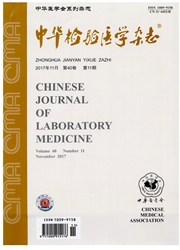

 中文摘要:
中文摘要:
目的应用双向电泳及质谱技术对野生型及变异型白细胞介素13(IL-13)刺激后的ASMC总蛋白进行差异比较研究,借此分析差异表达蛋白与支气管哮喘的关系,为哮喘的治疗提供新的靶标。方法用固相pH双向电泳分离,分别给予野生型IL-13及变异型IL-13刺激的ASMC总蛋白组成分,找出异常IL-13处理后与野生型IL-13处理后有明显差别的蛋白斑点,用基质辅助激光解吸电离飞行时间串联质谱(MALDI-TOF)进行鉴定部分差异蛋白质。结果获得了分辨率高,重复性好的电泳图谱,在野生型IL-13刺激组和变异型IL-13刺激组分别平均有(840±21)个和(892±17)个蛋白点(n=3)被检测,匹配的点数为(685±19)个,选取5个未匹配点做质谱分析,鉴定其中3个分别为stathmin1,Ribosomalproteinpo,NADHdehydrogenase。结论本研究结果显示不同处理组的ASMC总蛋白表达存在差异,这些差异蛋白有可能为阐明野生型IL-13及其变异体引发哮喘机制提供新的实验证据。
 英文摘要:
英文摘要:
Objective To analyze the differential proteomics of ASMC stimulated by wild IL-13 and mutant IL-13 and to investigate the relations of protein profiles of ASMC to asthma and possible targets for the treatment of bronchial asthma. Methods The total proteins of ASMC stimulated by wild IL-13 and mutant IL-13 were separated by immobilized pH gradient (IPG)-based 2-DE and the differentially expressed protein spots were identified by matrix assisted laser desorption-time of flight mass spectrometry (MALDI-TOF-MS). Results The 2-DE detected approximately (840 ±21) spots on wild IL-13 samples and (892 ± 17) spots on mutant IL-13 samples (n=3) and (685 ± 19) spots matched. Six significantly differential proteins were subjected to MALDI-TOF-MS analysis and three of them were identified as stathmin 1, Ribosomal protein p0 and NADH dehydrogenase. Conclusions ASMCs stimulated by wild IL-13 and mutant IL-13 present different proteomic profiles that may shed some light on the mechanism for the asthma causing effect of wild IL-13 and mutant IL-13.
 同期刊论文项目
同期刊论文项目
 同项目期刊论文
同项目期刊论文
 期刊信息
期刊信息
